 Office of Management and Budget
Office of Management and Budget
Program Category
The broadest grouping of programs presented in the Budget document.
Statewide Program
A high level, functional grouping of related programs.
Objectives
A statement of specific, measurable accomplishments related to the need, problem or opportunity the program is designed to address
Program Classes
Low level, operating program functions grouped together under statewide programs. It is the level at which Appropriations are made.
Program Classification Code
Program Classification Account code.

Evaluation Data
Evaluation Data provides measurements of workload effectiveness and efficiency.

Original and Supplemental
The Original and Supplemental column represents the original appropriation for current fiscal year as enacted by the Legislature on July 1. This column also includes the total of all supplemental appropriations which were enacted by the Legislature and signed into law by the Governor during current fiscal year

Reappropriations and Receipts
Reappropriations and Receipts column contains two separate items: Reappropriations, which represent funds that remained unexpended from a prior fiscal year and were made available for spending purposes in the budget year. Reappropriations are usually restricted to certain programs or accounts with multi-year obligations, such as Capital Accounts, where rehabilitation or construction projects typically take several years. Receipts represent dedicated taxes or fees which are credited to a specific account or agency. An example of receipts are funds collected for Hunters and Anglers’ programs from license fees. Receipts are indicated by a superscript “R”.

Transfers and Emergencies
Transfers and Emergencies are either Transfers, which represents monies which were either transferred between departments and agencies or between fund categories, or Emergencies, which represent an allocation of funds to an agency from the State Emergency Fund to meet unanticipated spending requirements. In the tables within the Budget Recommendation section, emergency transfers are indicated by a superscript “E”.

Total Available
Total Available is the total of the original and supplemental appropriations plus any reappropriations and receipts plus or minus transfers and emergency funds.

Program Classes
Low level, operating program functions grouped together under statewide programs. It is the level at which Appropriations are made.

Adjusted Appropriation
Adjusted Appropriation represents the current fiscal year appropriation, adjusted to include any distributions made from central, interdepartmental accounts to cover employee cost of living adjustments, etc., as well as any supplemental appropriations which were enacted prior to the printing of the Budget or anticipated through year end.

Requested
The Requested column represents the amount requested by the various Executive departments and agencies and other branches of government.

Recommended
The Recommended Budget column represents the Governor’s proposal to the Legislature.

Direct State Services
One of the major subdivisions of the State budget, this category includes all general operating costs of State government, including programs that provide services directly to the public.
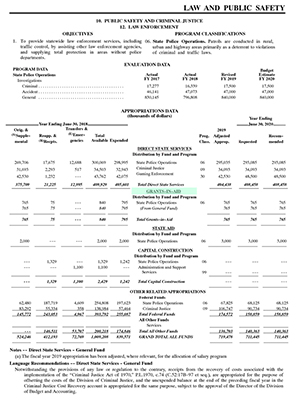
Grants-In-Aid
One of the major subdivisions of the State budget, this category includes all payments not otherwise defined as State Aid made to individuals, public agencies, or private agencies for benefits or services of three types:
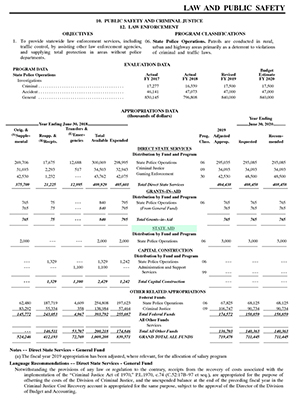
State Aid
One of the major subdivisions of the State budget; this category shall mean:
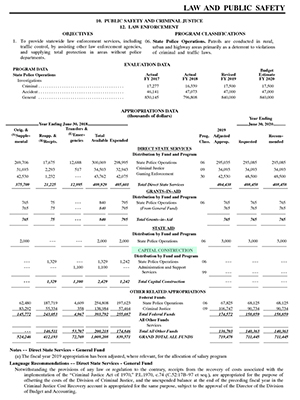
Capital Construction
This category includes funds budgeted for:
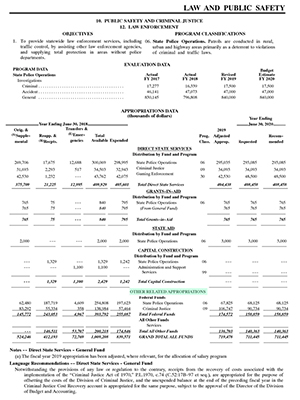
Other Related Appropriations
Other Related Appropriations, also called below-the-line appropriations, are summarized in the Direct State Services presentation in order to provide an overview of agency budgets encompassing all spending categories and funding sources.
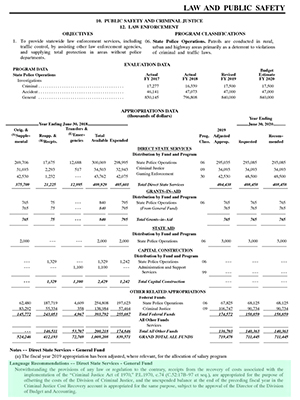
Appropriation Language
Appropriation Language is as important as the fiscal recommendations. It sets limits and conditions on the use of appropriations.